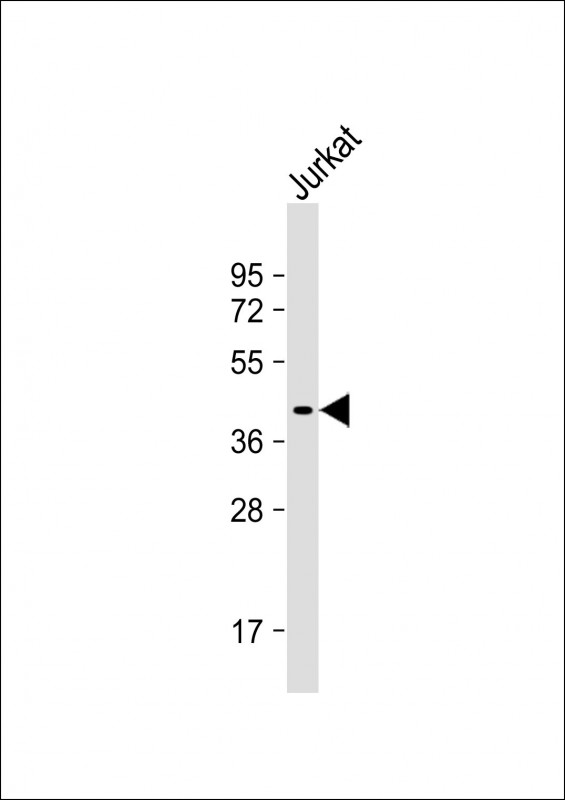DNMT3L Antibody (C-term)
Affinity Purified Rabbit Polyclonal Antibody (Pab)
- 产品详情
- 实验流程
- 背景知识
Application
| WB, E |
|---|---|
| Primary Accession | Q9UJW3 |
| Other Accession | NP_037501.2 |
| Reactivity | Human |
| Host | Rabbit |
| Clonality | Polyclonal |
| Isotype | Rabbit IgG |
| Calculated MW | 43583 Da |
| Antigen Region | 355-381 aa |
| Gene ID | 29947 |
|---|---|
| Other Names | DNA (cytosine-5)-methyltransferase 3-like, DNMT3L |
| Target/Specificity | This DNMT3L antibody is generated from rabbits immunized with a KLH conjugated synthetic peptide between 355-381 amino acids from the C-terminal region of human DNMT3L. |
| Dilution | WB~~1:1000 E~~Use at an assay dependent concentration. |
| Format | Purified polyclonal antibody supplied in PBS with 0.09% (W/V) sodium azide. This antibody is purified through a protein A column, followed by peptide affinity purification. |
| Storage | Maintain refrigerated at 2-8°C for up to 2 weeks. For long term storage store at -20°C in small aliquots to prevent freeze-thaw cycles. |
| Precautions | DNMT3L Antibody (C-term) is for research use only and not for use in diagnostic or therapeutic procedures. |
| Name | DNMT3L |
|---|---|
| Function | Catalytically inactive regulatory factor of DNA methyltransferases that can either promote or inhibit DNA methylation depending on the context (By similarity). Essential for the function of DNMT3A and DNMT3B: activates DNMT3A and DNMT3B by binding to their catalytic domain (PubMed:17687327). Acts by accelerating the binding of DNA and S-adenosyl-L-methionine (AdoMet) to the methyltransferases and dissociates from the complex after DNA binding to the methyltransferases (PubMed:17687327). Recognizes unmethylated histone H3 lysine 4 (H3K4me0) and induces de novo DNA methylation by recruitment or activation of DNMT3 (PubMed:17687327). Plays a key role in embryonic stem cells and germ cells (By similarity). In germ cells, required for the methylation of imprinted loci together with DNMT3A (By similarity). In male germ cells, specifically required to methylate retrotransposons, preventing their mobilization (By similarity). Plays a key role in embryonic stem cells (ESCs) by acting both as an positive and negative regulator of DNA methylation (By similarity). While it promotes DNA methylation of housekeeping genes together with DNMT3A and DNMT3B, it also acts as an inhibitor of DNA methylation at the promoter of bivalent genes (By similarity). Interacts with the EZH2 component of the PRC2/EED-EZH2 complex, preventing interaction of DNMT3A and DNMT3B with the PRC2/EED-EZH2 complex, leading to maintain low methylation levels at the promoters of bivalent genes (By similarity). Promotes differentiation of ESCs into primordial germ cells by inhibiting DNA methylation at the promoter of RHOX5, thereby activating its expression (By similarity). |
| Cellular Location | Nucleus. |
| Tissue Location | Expressed at low levels in several tissues including testis, ovary, and thymus. |
For Research Use Only. Not For Use In Diagnostic Procedures.
Provided below are standard protocols that you may find useful for product applications.
BACKGROUND
CpG methylation is an epigenetic modification that is important for embryonic development, imprinting, and X-chromosome inactivation. Studies in mice have demonstrated that DNA methylation is required for mammalian development. This gene encodes a nuclear protein with similarity to DNA methyltransferases. This protein is not thought to function as a DNA methyltransferase as it does not contain the amino acid residues necessary for methyltransferase activity. However, this protein does stimulate de novo methylation by DNA cytosine methyltransferase 3 alpha and it is thought to be required for the establishment of maternal genomic imprints. This protein also mediates transcriptional repression through interaction with histone deacetylase 1. Alternative splicing results in two transcript variants. An additional splice variant has been described but its biological validity has not been determined.
REFERENCES
Holz-Schietinger, C., et al. J. Biol. Chem. 285(38):29091-29100(2010)
Manderwad, G.P., et al. Arch. Pathol. Lab. Med. 134(8):1193-1196(2010)
Kim, H., et al. Int. J. Oncol. 36(6):1563-1572(2010)
Minami, K., et al. Clin. Cancer Res. 16(10):2751-2759(2010)
Haggarty, P., et al. PLoS ONE 5 (6), E11329 (2010) :
终于等到您。ABCEPTA(百远生物)抗体产品。
点击下方“我要评价 ”按钮提交您的反馈信息,您的反馈和评价是我们最宝贵的财富之一,
我们将在1-3个工作日内处理您的反馈信息。
如有疑问,联系:0512-88856768 tech-china@abcepta.com.























 癌症的基本特征包括细胞增殖、血管生成、迁移、凋亡逃避机制和细胞永生等。找到癌症发生过程中这些通路的关键标记物和对应的抗体用于检测至关重要。
癌症的基本特征包括细胞增殖、血管生成、迁移、凋亡逃避机制和细胞永生等。找到癌症发生过程中这些通路的关键标记物和对应的抗体用于检测至关重要。 为您推荐一个泛素化位点预测神器——泛素化分析工具,可以为您的蛋白的泛素化位点作出预测和评分。
为您推荐一个泛素化位点预测神器——泛素化分析工具,可以为您的蛋白的泛素化位点作出预测和评分。 细胞自噬受体图形绘图工具为你的蛋白的细胞受体结合位点作出预测和评分,识别结合到自噬通路中的蛋白是非常重要的,便于让我们理解自噬在正常生理、病理过程中的作用,如发育、细胞分化、神经退化性疾病、压力条件下、感染和癌症。
细胞自噬受体图形绘图工具为你的蛋白的细胞受体结合位点作出预测和评分,识别结合到自噬通路中的蛋白是非常重要的,便于让我们理解自噬在正常生理、病理过程中的作用,如发育、细胞分化、神经退化性疾病、压力条件下、感染和癌症。






